Lotus Esprit
| Lotus Esprit | |
|---|---|
|
| |
| Overview | |
| Manufacturer | Lotus Cars |
| Production | 1976–2004 (10,675 built[1]) |
| Assembly | Hethel, Norfolk, England |
| Body and chassis | |
| Class | Sports car |
| Body style | 2-door coupé |
| Layout | Longitudinal, Rear mid-engine, rear-wheel drive |
| Related | Lotus Esprit GT1 |
| Powertrain | |
| Transmission | 5-speed manual |
| Dimensions | |
| Curb weight | 2,690 lb (1,220 kg) unladen (typical) |
The Lotus Esprit is a sports car that was built by Lotus in the United Kingdom between 1976 and 2004. The silver Italdesign concept that eventually became the Esprit was unveiled at the Turin Motor Show in 1972 as a concept car, and was a development of a stretched Lotus Europa chassis. It was among the first of designer Giorgetto Giugiaro's polygonal "folded paper" designs. Originally, the name Kiwi was proposed, but in keeping with the Lotus tradition of having all car model names start with the letter "E", the name became Esprit.
S1 (1976)
| First generation | |
|---|---|
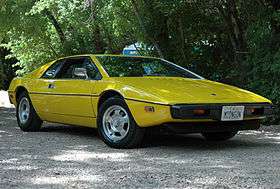 | |
| Overview | |
| Production | 1976–1978 |
| Designer | Giorgetto Giugiaro[2] |
| Powertrain | |
| Engine | 2.0 L type 907 I4 |
| Dimensions | |
| Wheelbase | 96 in (2,438.4 mm) |
| Length | 165 in (4,191.0 mm) |
| Width | 73 in (1,854.2 mm) |
| Height | 44 in (1,117.6 mm) |
The Esprit was launched in October 1975 at the Paris Auto Show, and went into production in June 1976, replacing the Europa in the Lotus model lineup. These first cars eventually became known as S1 (or Series 1) Esprits. With a steel backbone chassis and a fiberglass body, the Esprit was powered by the Lotus 907 4-cylinder engine, as previously used in the Jensen Healey. This engine displaced 2.0 L, produced 160 bhp (119 kW; 162 PS) in European trim 140 bhp (104 kW; 142 PS) in US/Federal trim, and was mounted longitudinally behind the passengers, as in its predecessor. The transaxle gearbox was a 5 speed manual unit, previously used in the Citroën SM and Maserati Merak; it featured inboard rear brakes, as was racing practice at the time. The Series 1 embodied Lotus' performance through light weight mantra, weighing less than 1,000 kg (2,205 lb).
The original Esprit was lauded for its handling and is said to have the best steering of any Esprit. However, it was generally regarded as lacking power, especially in markets such as the United States where the engine was downrated for emissions purposes. Lotus' claim of 0-60 mph in 6.8 seconds and a top speed of 138 mph (222 km/h) may be thought of as optimistic - actual road test times indicated 0-60 mph in 8 seconds and a top speed of around 133 mph (214 km/h).[3]
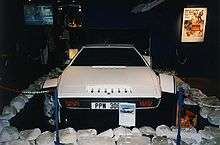
The S1 Esprit can be distinguished from later Esprits by a shovel style front air dam, Fiat X1/9 tail lights, lack of body side ducting, and Wolfrace alloy wheels. Inside the car, the most obvious indication of an S1 Esprit is a one piece instrument cluster with green faced Veglia gauges.
The car gained fame through its appearance in the James Bond film The Spy Who Loved Me (1977) where a fictionally modified version was featured in a long action sequence. Bond's Esprit car is first chased on road, by a motorcycle, then by another car, and then a helicopter, then converts into a submarine for an undersea battle.[4] The film's Perry Oceanographic built submarine "Wet Nellie" was bought by businessman Elon Musk at auction for £650,000 in September 2013 by RM Auctions at Battersea Park, London.[5] Musk plans to install a Tesla electric powertrain in the submarine S1 and make it able to actually transform from a road-going car to a submarine.[6]
S2 (1978)
| Second generation | |
|---|---|
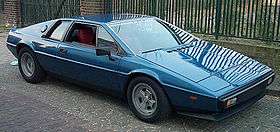 | |
| Overview | |
| Production | 1978–1981 |
| Powertrain | |
| Engine |
2.0 L type 907 I4 2.2 L type 912 I4 |
A series of improvements made to the Esprit during its initial run culminated in the S2 (or Series 2) Esprit, which was introduced in 1978.[7] The most obvious of these changes are intake and cooling duct "ears" located behind the rear quarter window, tail lights from the Rover SD1, and an integrated front spoiler. S2 Esprits also used 14-inch (360 mm) Speedline alloy wheels designed specifically for Lotus. Other changes included relocating the battery from above the right side fuel tank (under the rear quarter window) to the rear of the car, adding an access door to the engine cover, as well as replacing the instrument cluster made by Veglia with individual gauges made by Smiths and using different style of switches on the dashboard.
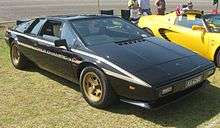
During this era, a special edition car was released to commemorate Lotus's racing victories and their victory in the 1978 F1 World Championship. Sharing the black and gold colour scheme of Lotus' then F1 sponsor, John Player & Sons, these cars are commonly known as the John Player Special (JPS) Esprits. The "JPS" Esprit has the same mechanicals as the regular two-litre S2. According to Lotus themselves a limited series of 300 was built, but most likely the total was considerably lower.[8] Lotus' records of production figures are notoriously vague, but best estimates suggest that 149 JPS Esprits were produced.[9]
The S2.2 was produced as a stop-gap model from May 1980, almost identical to the S2 but with an enlarged (2.2 L) type 912 engine used.[10] This kept horsepower the same, but bumped up torque from 140 lb·ft (190 N·m) to 160 lb·ft (217 N·m). Importantly, the S2.2 also introduced the use of a galvanised chassis, although it did not benefit from the succeeding S3's chassis improvements. These cars are extremely rare even among Esprits: according to Lotus themselves, only 88 were produced in its thirteen-month production span.[11]
Essex Turbo Esprit (1980)

In 1980 the first factory turbocharged Esprit was launched. Initially, this was another special edition model commemorating F1 ties and reflecting current sponsorship, this time in the blue, red and chrome livery of Essex Petroleum, and is therefore known as the Essex Esprit. The new turbocharged dry-sump type 910 engine produced 210 hp (157 kW) and 200 lb·ft (270 N·m) of torque. 0-60 mph could be achieved in 6.1 seconds, with a top speed of 150 mph (240 km/h).
These performance improvements were coupled to a redesign and strengthening of the chassis and rear suspension, where an upper link was added to alleviate strain on the driveshafts, along with brake improvements.[12] The Essex cars introduced a Giugiaro-designed aerodynamic body kit with a rear lip spoiler, prominent louvered rear hatch, more substantial bumpers, a deeper front airdam, and air ducts in the sills just ahead of the rear wheels, which were 15" Compomotive three piece items. Internally, scarlet leather, combined with a roof-mounted Panasonic stereo, made for a dramatic environment.
45 Essex Esprits were built, interspersed and followed by a number of non Essex-liveried but otherwise identical specification dry-sump turbo cars. Two Essex-spec Turbo Esprits - one in white and the other in copper - were featured in the James Bond film For Your Eyes Only (1981), although these were scripted as the same vehicle - the white one was destroyed by an anti-burglar explosion system in Spain, while the copper red one was a "rebuild" of the original (actually a joke between Bond and Q in the latter's laboratory), and was fully functional (the copper exterior paint colour for the replacement car was chosen to make the car stand out more in filming against the snowy background of Cortina, Italy, the only locale in which it appears).[13]
Turbo Esprit and S3
| Third generation | |
|---|---|
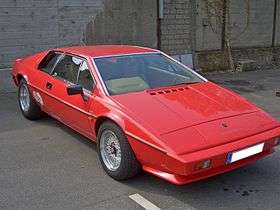 | |
| Overview | |
| Production | 1981–1987 |
| Powertrain | |
| Engine |
2.2 L type 912 I4 2.2 L type 910/910S turbo I4 |
| Transmission | 5-speed manual transmission |
| Dimensions | |
| Wheelbase | 2,440 mm (96.1 in) |
| Length | 4,225–4,290 mm (166.3–168.9 in) |
| Width | 1,860 mm (73.2 in) |
| Height | 1,110–1,120 mm (43.7–44.1 in) |
By the close of 1980, Lotus was effectively building three different models of Esprit, with distinct chassis designs and body moulds - the Domestic (i.e. UK) S2.2, the Export S2.2, and the dry-sump Turbo Esprit. Introduced in April 1981, the Turbo Esprit and S3 (Series 3) Esprits marked a necessary consolidation: both new models had a common chassis, inheriting much of the configuration of the Essex cars, whilst body production was based on a single common set of moulds.
.jpg)
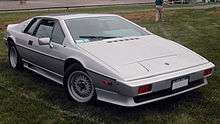
The S3 continued to use the 2.2 L type 912 engine of the S2.2, whilst the Turbo Esprit reverted to a less complex wet-sump lubrication system, retaining the power and torque outputs of its dry-sump predecessor. The interior for both cars was revised and featured new trim; combined with changes to the body moulds this resulted in more headroom and an enlarged footwell.[12] Externally, the Turbo Esprit retained the full aerodynamic body kit of the Essex cars, and featured prominent 'turbo esprit' decals on the nose and sides; the S3 gained the more substantial bumpers, yet retained the simpler sill line and glazed rear hatch of the S2.2 body style. Both models were supplied with 15" BBS alloy wheels.
For the 1985 model year, the S3 and Turbo underwent some slight alterations to the bodywork and to the front suspension.[14]
In April 1986, the final incarnations of the Giugiaro-styled Esprit were announced, with raised engine compression giving rise to the 'HC' moniker. This increased the output of the naturally aspirated engine to 172 hp (128 kW; 174 PS) and 160 lb·ft (217 N·m) for the Esprit HC, and to 215 hp (160 kW; 218 PS) and 220 lb·ft (298 N·m) for the Turbo Esprit HC, with the increased torque available at a lower rpm.[15]
For markets with stringent emissions requirements (mainly the United States), Lotus introduced the HCi variant, teaming the higher compression engine with Bosch KE-Jetronic fuel injection and a catalytic converter- the first fuel-injected Esprits. This engine had the same peak power as the carburetted version, but at a somewhat higher engine speed, and torque dropped to 202 lb·ft (274 N·m).[14]
Peter Stevens redesign (1987)
| Fourth generation | |
|---|---|
|
| |
| Overview | |
| Production | 1987–1993 |
| Designer | Peter Stevens |
| Powertrain | |
| Engine |
2.0 L type 920 turbo I4 (Italy only)[16] 2.2 L type 912 I4 2.2 L type 910/910S turbo I4 |
In 1987, a new version of the Esprit was unveiled, incorporating rounder styling cues given by designer Peter Stevens (who later designed the McLaren F1). A new Lotus patented process was introduced to create the new body, called the VARI (Vacuum Assisted Resin Injection) process, which offered more advantages than the previous hand laid process. Kevlar reinforcement was added to the roof and sides for roll-over protection,[17] resulting in an increase of the Esprit's torsional rigidity by 22 percent.[18] Giugiaro is said to have liked the restyling, claiming it was perhaps too close to his original design. The Stevens styled cars retained the mechanical components of the previous High Compression Esprit and Turbo Esprit, but introduced a stronger Renault transaxle, which necessitated a move to outboard rear brakes. However, the MY 1988 North American Esprit Turbo kept its Citroën SM type transaxle and the Bosch K-Jetronic fuel injection system used in the previous model year.
The car's Type 910 engine retained 215 bhp (160 kW; 218 PS) and 220 lb·ft (298 N·m), but decreased its zero to sixty from 5.6 seconds to a varied time between 5.4[19] - 5.1[20] seconds and a top speed of over 150 mph (240 km/h). The exterior style changes were accompanied by a redesign of the interior, allowing a little more space for the occupants. The Stevens styled Esprit is often known by its project code of X180.
In 1989, the Esprit was again improved with the GM multi-port, electronic fuel injection system and the addition of a water to air intercooler, which Lotus has named the Chargecooler,[21] producing the SE (Special Equipment). This inline-four engine was known as the Type 910S. Horsepower was pushed up to 264 with 280 available on overboost and zero to sixty miles per hour times reduced to 4.7 seconds with a top speed of over 160 mph (260 km/h).[22] Several modifications were made to the body kit as well, like side skirts which are parallel to the body, five air ducts in the front air dam, wing mirrors from the Citroën CX and the addition of a rear wing.

Along with the SE, Lotus produced the little seen Esprit S, a midrange turbocharged car offering fewer appointments and 228 hp (170 kW), as well as the standard turbo still offering 215 hp (160 kW). The N/A and lower-powered turbo were cancelled after 1990, and the S in 1991. Another unusual variant was a two-litre "tax special" developed for the Italian market, fitted with an intercooled and turbocharged version of a new 1,994 cc (2.0 L) version of the venerable 900-series four-cylinder engine. Equipped with SE trim, this appeared in December 1991 and produced 243 PS (179 kW) at 6,250 rpm.[16] Beginning in the fall of 1996, this engine became available in other markets as well.
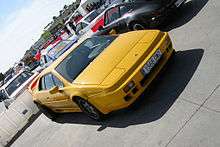
The Esprit was a popular and successful addition to the American IMSA Bridgestone Supercar Championship and as a result Lotus produced the SE-based X180R, with horsepower bumped to 300 and with racing appointments. The Sport 300 was a derivative of the X180R sold in Europe, which included many modifications.[23] These are known as the fastest of the four-cylinder Esprits and among the most desirable.[24]
The Stevens Esprit played a role in the film Pretty Woman after Ferrari and Porsche declined the product placement opportunity because the manufacturers did not want to be associated with soliciting prostitutes. Lotus saw the placement value with such a major feature film and supplied a Silver 1989.5 Esprit SE. Despite this, Esprit sales and productions fell sharply in 1991 and 1992. [25]
The car was also seen in Basic Instinct, The Rookie, Taking Care of Business and If Looks Could Kill / Teen Agent, as well as the short-lived TV series The Highwayman.[26]
Julian Thomson redesign (1993)
| Fifth generation | |
|---|---|
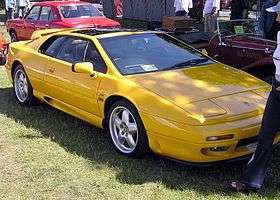 | |
| Overview | |
| Production | 1993–2004 |
| Designer | Julian Thomson |
| Powertrain | |
| Engine |
2.0 L type 920 turbo I4 2.2 L type 910S turbo I4 3.5 L type 918 twin-turbo V8 |
| Dimensions | |
| Wheelbase |
2002–04: 95.3 in (2,421 mm) 1993–2001: 96.0 in (2,438 mm) |
| Length |
1993–95 & 1999–2004 172.0 in (4,369 mm) 1996–98: 173.8 in (4,415 mm) |
| Width |
1993–95 & 1999–2001: 73.5 in (1,867 mm) 1996–98 & 2002–04: 74.1 in (1,882 mm) |
| Height | 45.3 in (1,151 mm) |
In 1993, another exterior and interior revamp of the car resulted in the S4 which was the first model to include power steering. The exterior redesign was done by Julian Thomson,[27] which included a smaller rear spoiler placed halfway up the rear decklid. Other major changes were to the front and rear bumpers, side skirts and valence panels. New five spoke alloy wheels were also included in the redesign. The S4 retained the same horsepower as the SE at 264 hp (197 kW).

The S4 was succeeded in 1994 by the S4s (S4 sport), which upped power to 300 bhp (224 kW; 304 PS) and 290 lb·ft (393 N·m) of torque, improving all-around performance while retaining the comfort of the previous version. Top speed was increased to 168 mph (270 km/h), skidpad increased to 0.91g, an increased slalom of 61.7 mph[28] and a 0-60 mph time of 4.6 seconds.[29] Although the engine kept its 2.2-litre capacity, many modifications were added to improve engine performance. Some of the changes were enlarged inlet ports, cylinder head modifications, a re-calibrated ECM and a revised turbocharger.[30] The most visible external styling changes was the addition of a larger rear wing taken from the Sport 300.
This car was to be the end of the line for the Esprit but a cancelled project for a front engine car had left Lotus with a compact V8 and no car to put it into.
V8 (1996)
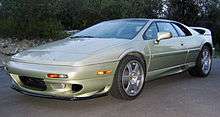
In 1996 the Esprit V8 used Lotus' self-developed all-aluminium, twin-turbocharged (Garrett T25/60 turbos) 90-degree V-8, Code-named Type 918, in front of the same Renault transmission as before with no Chargecooler. Derek Bell developed an uprated gearbox that overcame a lot of the gearbox problems with a much thicker single piece input shaft. The Type 918 engine was detuned from a potential 500 bhp (373 kW; 507 PS) to 350 bhp (261 kW; 355 PS) to prevent gearbox damage due to the fragility of the Renault UN-1 transmission.[31] In period tests, zero to sixty miles per hour came in at 4.4 seconds and top speeds of over 175 mph (282 km/h) were achieved.[32][33]
Produced alongside V8 models was the GT3, a turbocharged four-cylinder car with the type 920 2.0 L chargecooled and turbocharged engine which had been used only in Italian market cars previously.
In 1998 the V8 range was split into SE and GT specifications, both cars with a much changed interior configuration, both offering similar performance with the SE being the more luxurious of the two.
The ultimate incarnation of the Esprit came in 1999 with the Sport 350. Only 50 were made,[34] each offering 350 horsepower (per the name) and various engine, chassis and braking improvements, like the addition of AP Racing brakes, stiffer springs and a revised ECU.[35] Several visual changes were made as well, including the addition of a large carbon fiber rear wing on aluminium uprights in place of the standard fibreglass rear wing. By this time the Esprit could reach 60 mph (100 km/h) in 4.3[36] seconds as well as reaching 0-100 mph in less than 10 seconds,[37] and weighed 1,300 kg (2,866 lb) as a result of many modifications.
Thereafter, Lotus made little development aside from minor cosmetic changes including a switch to four round tail lights for the 2002 model year. Esprit production ceased in February 2004 after a 28-year production run. A total of 10,675 Esprits were produced.
Proposed new Esprit

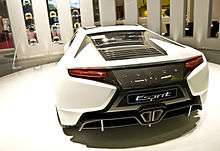
At the 2010 Paris Motor Show, along with four other proposed new cars (all subsequently cancelled), Lotus unveiled a completely redesigned new generation Esprit, then scheduled to go into production in late 2013 and to go on sale in the Spring of 2014.[38]
This new Esprit was to have featured a futuristic front-end with LED front daytime running lights and a center-mounted dual exhaust system in the rear. The interior was to have a futuristic but minimal design which included a digital instrument cluster, a sport steering wheel and carbon fiber trim scattered throughout the cabin. The design exhibited had a length of 455 cm (179.1 inches), a width of 195 cm (76.8 inches) and a height of 125 cm (49.2 inches). Gross weight was stated to be around 1495 kg (3,296 lbs).
On September 29, 2014, Lotus announced that the new Esprit would not go ahead.[39]
Esprit designers
Giorgetto Giugiaro
- Esprit – 1976–78
- Esprit S2 – 1978–81
- Esprit JPS (John Player Special) – 1978–79
- Esprit JPS ("JPS Mario Andretti Edition") - 1979
- Esprit S2.2 – 1980–81
- Esprit Essex – 1980
- Esprit S3 – 1981–86
- Turbo Esprit – 1981–86
- Esprit S3 HC – 1986–87
- Turbo Esprit HC – 1986–87
- Turbo Esprit HCi (Bosch Fuel Injected) – 1986–87
Peter Stevens
- Esprit – 1987–90
- Esprit Turbo – 1987–90
- Esprit SE – 1989–91
- Esprit S – 1991
- Lotus Esprit X180R - 1991-92
- Esprit SE HighWing – 1992–93
Julian Thomson
- Esprit S4 – 1993–96
- Esprit 300 Sport – 1993
- Esprit S4s – 1995–96
- Esprit V8 – 1996–98
- Esprit GT3 – 1996–99
- Esprit V8 GT – 1998–2001
- Esprit V8 SE – 1998–2001
- Esprit Sport 350 – 1999
- Esprit V8 – 2002–04
Parts
As with many of their cars, Lotus used parts from other cars to cut down development costs. Esprits before 1993 have many British Leyland parts and after 1993 have many GM (Vauxhall, Opel) parts. G Esprits have Citroën gearboxes as found in the Citroën SM and Maserati Merak, while S Esprits have Renault UN1 gearboxes, with the exception of the North American Esprit Turbo which retained the Citroen gearbox for 1988 only.[40] The door handles come from Morris Marina / Austin Allegro and were kept until the S4 model in 1994 when instead GM Calibra door handles were used. Early models used a Momo steering wheel, later ones had the same as the Pontiac Trans Am. S1 Esprits have Fiat X1/9 rear light units. S2 and S3 Esprit used Rover SD1 rear light units. On Esprit S4 until 2002 it had rectangular rear lights borrowed from the Toyota AE86, later replaced with the same round light as the Lotus Elise II. Headlight lift motors came from the Pontiac Fiero. The aerial mount and whip on the S4 and V8 is the same as the GM Calibra and Tigra. The side mirrors are from the Citroën CX. Non SE foglamps from about 1989 are GM Astra MK1. The fan motors come from the Ford Fiesta Mk2. The alternator on the V8 models is a standard GM unit also found in the V6 Opel Omega B and the earlier Lotus Carlton/Omega which also provides many of the interior plastic fittings such as door handles and steering column. The clutch slave cylinder on the 98 onwards models is the same as a series 2A Land Rover from Girling as is the master cylinder.[41] The front suspension of the S1 and S2 came from the Opel Ascona. Front GT3 Brake Pads (Brembo) are the same as on a Fiat Coupe turbo or a Peugeot 406 3.0 V6. The Fuel Pump of SE is salvaged from Renault Fuego cars.
Motorsports
Doc Bundy won the 1992 IMSA Bridgestone Supercar Championship drivers title with the Esprit X180R. The Esprit has been used by Thorkild Thyrring to win his class in the 1993 and 1994 British GT Championship, and also by Richard Piper, Peter Hardman and Olindo Iacobelli in the 1993 and 1994 24 Hours of Le Mans.
Brad Jones won the 1994 Australian Super Production Car Series driving an Esprit.
See also
| Wikimedia Commons has media related to Lotus Esprit. |
- Lotus Esprit GT1
- Lotus Esprit Turbo Challenge, early 1990s video game on the Amiga computer.
- Pegasus WSC, a short-lived IMSA GT Championship car based on the Esprit.
- Turbo Esprit, 1986 video game
Notes and references
- ↑ "Esprit History: Esprit Production Figures". Lotus Esprit World. Retrieved 2011-12-21.
- ↑ "Designer". ajovalo.net. Retrieved 2012-02-08.
- ↑ "Lotus Esprit S1". lotusespritworld.com. Retrieved 2007-12-17.
- ↑ Hopper, Andrew (2013-07-03). "James Bond's Lotus submarine car for sale". The Telegraph. London. Retrieved 2013-07-16.
- ↑ "James Bond's submarine Lotus Esprit car sold at auction". BBC News. 2013-09-09.
- ↑ "Elon Musk buys James Bond's Lotus submarine, wants to install Tesla powerplant". Autoblog. 18 October 2013. Retrieved 30 September 2014.
- ↑ Esprit S2 Retrieved from www.lotusespritworld.com on 16 January 2011
- ↑ Prosser, Dan (September 2014). "Black Gold". Evo. Wellingborough, UK: Dennis Publishing (199): 114.
- ↑ "JPS Commemorative Esprit Online Register". king.igs.net/~nadb/jps.htm. Retrieved 2008-11-26.
- ↑ Büschi, Hans-Ulrich, ed. (5 March 1987). Automobil Revue 1987 (in German and French). 82. Berne, Switzerland: Hallwag AG. p. 352. ISBN 3-444-00458-3.
- ↑ Walton, Jeremy (1991), Lotus Esprit: The Complete Story, Ramsbury, Wiltshire, UK: The Crowood Press, p. 90, ISBN 1-86126-066-0
- 1 2 Robson, Graham. "Lotus Turbo Esprit". lotusespritturbo.com. Retrieved 2008-02-02.
- ↑ "James Bond 007 Lotus Esprit Turbo For Your Eyes Only". The Bond Museum. Retrieved 2011-03-20.
- 1 2 Automobil Revue 1987, p. 357
- ↑ "When the BOOST BLOWS". lotusespritworld.com/ERoadtests. Retrieved 2007-12-17.
- 1 2 Quattroruote: Tutte le Auto del Mondo 1992 (in Italian). Milano: Editoriale Domus S.p.A. 1992. p. 448.
- ↑ kato. "Esprit: VARI Process". Lotusespritworld.com. Retrieved 2010-05-16.
- ↑ kato. "Esprit Road Tests". Lotusespritworld.com. Retrieved 2010-05-16.
- ↑ kato. "Esprit Road Tests". Lotusespritworld.com. Retrieved 2010-05-16.
- ↑ "The Lotus Esprit Fact File - Model Information". Espritfactfile.com. 1990-10-09. Retrieved 2010-05-16.
- ↑ "The Lotus Esprit Fact File - Model Information". Espritfactfile.com. 1990-10-09. Retrieved 2010-05-16.
- ↑ kato (1989-05-10). "Esprit Models". Lotusespritworld.com. Retrieved 2010-05-16.
- ↑ "The Lotus Esprit Fact File - Model Information". Espritfactfile.com. 1990-10-09. Retrieved 2010-05-16.
- ↑ "Lotus Esprit Sport 300". lotusespritworld.com/ERoadtests/300. Retrieved 2007-12-17.
- ↑ "Production Figures". lotusespritworld.com/EHistory/Production_Figures.
- ↑ "Lotus Esprit World - Esprit on the Silver Screen". Travelhead.com. Retrieved 2010-10-10.
- ↑ "The Lotus Esprit Fact File - Model Information". Espritfactfile.com. 1990-10-09. Retrieved 2010-05-16.
- ↑ kato. "Esprit Road Tests". Lotusespritworld.com. Retrieved 2010-05-16.
- ↑ kato. "Esprit Models". Lotusespritworld.com. Retrieved 2010-05-16.
- ↑ "The Lotus Esprit Fact File - Model Information". Espritfactfile.com. 1990-10-09. Retrieved 2010-05-16.
- ↑ "Esprit". Espritfactfile.com. 1990-10-09. Retrieved 2010-10-10.
- ↑ "Lotus Esprit V8 - European Car - Specifications - Motor Trend Magazine". Motortrend.com. Retrieved 2010-05-16.
- ↑ Mitani, Sam (November 1997). "Ferrari F355 Berlinetta vs. Lotus Esprit V8". Road & Track. Hearst: 73. Retrieved 2012-03-17.
- ↑ "Lotus Esprit 350". lotusespritworld.com/ERoadtests/350. Retrieved 2007-12-17.
- ↑ kato. "Esprit Models". Lotusespritworld.com. Retrieved 2010-05-16.
- ↑ Kuah, Ian. "Esprit Road Tests". Lotusespritworld.com. Retrieved 2010-05-16.
- ↑ kato. "Esprit Road Tests". Lotusespritworld.com. Retrieved 2010-05-16.
- ↑ Wed, Oct 06, 2010 @ 07:25 PM (2010-10-06). "kers | San Francisco Bentley, Lamborghini and Lotus". Info.britishmotorexotics.com. Retrieved 2011-03-20.
- ↑ "New Lotus Esprit Is Dead". MotorAuthority. 2014-09-29. Retrieved 2014-09-29.
- ↑ "Esprit Turbo". espritfactfile.com/espritturbo.html. Retrieved 2008-11-26.
- ↑ "Esprit Part Prices". lotusespritworld.com/ERunning. Retrieved 2007-12-17.
External links
- Lotus Esprit World - model specs, road test archive, parts, maintenance and 'howto' information
| Lotus production car timeline, 1950–present | |||||||||||||||||||||||||||||||||||||||||||||||||||||||||||||||||||
|---|---|---|---|---|---|---|---|---|---|---|---|---|---|---|---|---|---|---|---|---|---|---|---|---|---|---|---|---|---|---|---|---|---|---|---|---|---|---|---|---|---|---|---|---|---|---|---|---|---|---|---|---|---|---|---|---|---|---|---|---|---|---|---|---|---|---|---|
| Type | 1950s | 1960s | 1970s | 1980s | 1990s | 2000s | 2010s | ||||||||||||||||||||||||||||||||||||||||||||||||||||||||||||
| 0 | 1 | 2 | 3 | 4 | 5 | 6 | 7 | 8 | 9 | 0 | 1 | 2 | 3 | 4 | 5 | 6 | 7 | 8 | 9 | 0 | 1 | 2 | 3 | 4 | 5 | 6 | 7 | 8 | 9 | 0 | 1 | 2 | 3 | 4 | 5 | 6 | 7 | 8 | 9 | 0 | 1 | 2 | 3 | 4 | 5 | 6 | 7 | 8 | 9 | 0 | 1 | 2 | 3 | 4 | 5 | 6 | 7 | 8 | 9 | 0 | 1 | 2 | 3 | 4 | 5 | 6 | |
| Sports racer | Mark VIII | Mark IX | Eleven | 15 | 17 | 19 | 23 | 30 | 40 | 47 | 62 | ||||||||||||||||||||||||||||||||||||||||||||||||||||||||
| Mark VI | Seven | 340R | 2-Eleven | ||||||||||||||||||||||||||||||||||||||||||||||||||||||||||||||||
| Roadster | Elan | Elan M100 | Elise | Elise | |||||||||||||||||||||||||||||||||||||||||||||||||||||||||||||||
| Coupé | Elite | Elan | Exige | Exige | Exige | ||||||||||||||||||||||||||||||||||||||||||||||||||||||||||||||
| Eclat | Excel | Evora | |||||||||||||||||||||||||||||||||||||||||||||||||||||||||||||||||
| Grand tourer | Elan +2 | Elite | |||||||||||||||||||||||||||||||||||||||||||||||||||||||||||||||||
| Europa | Esprit | Europa S | |||||||||||||||||||||||||||||||||||||||||||||||||||||||||||||||||
| Saloon | Ford Cortina Lotus | Ford Cortina Lotus | Carlton/Omega | ||||||||||||||||||||||||||||||||||||||||||||||||||||||||||||||||
| Race cars | |||||||||||||||||||||||||||||||||||||||||||||||||||||||||||||||||||
| Related cars | |||||||||||||||||||||||||||||||||||||||||||||||||||||||||||||||||||
| Concept cars | |||||||||||||||||||||||||||||||||||||||||||||||||||||||||||||||||||
| Key figures | |||||||||||||||||||||||||||||||||||||||||||||||||||||||||||||||||||
| Group Lotus | |||||||||||||||||||||||||||||||||||||||||||||||||||||||||||||||||||